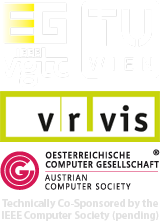Sections
Recent Articles

Authors' Guidelines Short Papers
Short paper submissions will undergo a one-stage, double-blind review process. All accepted short papers will be electronically archived and are fully citeable publications. They will be orally presented at the conference.
Short papers must be submitted until March 2, 2012, 11:59pm (23:59) UTC/GMT. All submissions must be original works that have not been published previously in any conference proceedings, magazine, journal, or edited book. Concurrent submissions are strictly forbidden. If it is determined that a manuscript is simultaneously under the consideration by another publication venue, the manuscript will be immediately rejected.
Short papers will undergo a double-blind review process. Author identities will be hidden from all reviewers. Authors should therefore not include their name or institution on the cover page of the initial submission, and should make an effort to ensure that there is no self-revealing information in the text. However, you will still need to provide a complete list of authors in the submission system (but not in the paper) so that the Short Paper Co-Chairs can avoid conflicts of interest during reviewer assignment. Adding additional authors after the acceptance of a paper is not acceptable.
Short papers will undergo a one-stage review process. They will be reviewed by at least three reviewers drawn from an international program committee. One of these reviewers (the primary) will write a summary recommendation. The final decision about acceptance is made by the Short Paper Co-Chairs.
At least one author of an accepted paper must attend the conference to present the work, and authors will also be required to present a brief summary of their talk at the opening papers preview session.
Based on the reviews, changes made to the manuscript after the reviews, and the presentation at the conference, the Short Paper Co-Chairs will select a short paper to receive the Best Short Paper Award.
A EuroVis short paper describes a more focused and concise research contribution and is likely to have a smaller - yet still significant - scope of contribution than a full paper.
We expect that the submissions will clearly discuss the contributions as well as place them in the context of prior art in the field. Authors should highlight how their contributions differ from previous work. Among the venues for important prior art are journals such as Computer Graphics Forum and IEEE Transactions on Visualization and Computer Graphics as well as conferences such as EuroVis, Vis, InfoVis, VAST, and PacificVis.
Authors should cite all relevant previous work and explain the differences between it and their paper, including their own previous work. Authors should do this in a way that does not reveal which references are part of their own work. For example, do not write "In our previous work on foobar [13] ... " and then have "[13] Removed for blind review" as the citation. Instead, discuss the work in the third person: "We build on the previous work of Smith et al. [13] ... " and include the full reference details. If it is impossible to do so, for instance because the work is submitted or in press but not yet publicly available, then include an anonymized version of the relevant document(s) with your submission as supplemental material. Authors should not include an acknowledgments section in the submission, nor should they post their submitted manuscript on the web before the notification date.
Our conference adheres to the VGTC ethics guidelines for reviewers, which can be found at http://vgtc.org/wpmu/techcom/conferences/ethics-guidelines/.
 Find us on Facebook
Find us on Facebook Join us on LinkedIn
Join us on LinkedIn